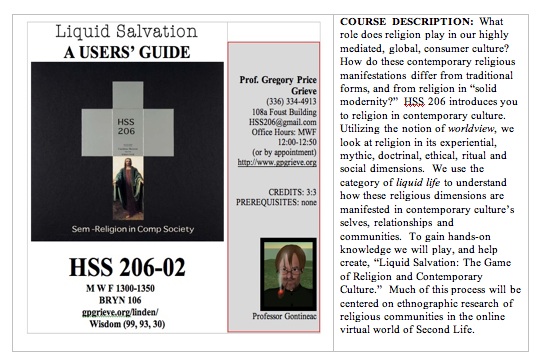

Grieve approaches teaching as an intellectual and creative endeavor that is an important element of his own research and scholarship. Like the "curious problems" that drive Grieve's scholarship, he believes the key for creating in students the habits of life long learning is posing curious questions-excellent teachers make the material interesting and pertinent to students. Curiosity is important, because effective teachers can use it to install in students the resources to critically research, think and write about their self-directed inquiries.

LIQUID SALVATION. What role does religion play in our highly mediated, global, consumer culture? How do these contemporary religious manifestations differ from traditional forms, and from religion in 'solid modernity?' HSS 206 introduces you to religion in contemporary culture. Utilizing the notion of worldview, we look at religion in its experiential, mythic, doctrinal, ethical, ritual and social dimensions. We use the category of liquid life to understand how these religious dimensions are manifested in contemporary cultureÝs selves, relationships and communities. To gain hands-on knowledge we will play, and help create, 'Liquid Salvation: The Game of Religion and Contemporary Culture.' Much of this process will be centered on ethnographic research of religious communities in the online virtual world of Second Life.
Course WebsiteWhat does it mean to be human? What rights does this guarantee us? How do cultural, religious, historical, and political contexts shape our conceptions of and claims to human rights? On December 10, 1948, the General Assembly of the United Nations adopted and proclaimed the Universal Declaration of Human Rights (UDHR), which states the "recognition of the inherent dignity and of the equal and inalienable rights of all members of the human family is the foundation of freedom, justice and peace in the world." More recent human rights instruments, such as the Bangkok Declaration of 1993, interpret and pursue such rights through a framework of norms, priorities, and procedures that reflect Asian cultural history and normative values. Using literature and film, as well as primary religious scripture (particularly Buddhist and Hindu), this seminar will focus on egregious human rights violations and humanitarian responses to them in four contexts: 1) Hinduism and Gandhi's politics of ahimsa (nonviolence) as it relates to the riots of Partition; 2) engaged Buddhist Thich Nhat Hahn's Theravadan teachings and his opposition to the Vietnam War (we will also include a short section on Theravadan Buddhism and military dictatorship in Myanmar or Burma); 3) the Dalai Lama's integration of human rights language and Tibetan Buddhism in working for Tibetan self-determination; and 4) the on-going conflict between Maoists, Hindu Royalists, and Parliamentarians in Nepal. The course facilitates an understanding of the meaning, basis, historical roots, and practical significance of human rights in Asia, with special attention given to questions of cultural and historical context, especially the incorporation of international human rights norms into domestic national settings. Each of the four units will examine literary, cinematic, and religious discourses that address historical trauma of the 20th and 21st centuries in Asia..
This course takes an imaginative and critical approach to introducing Religious Studies by focusing on case studies that illustrate how diverse religious ideas and practices may be interpreted as ways of map-making. Additionally, this course investigates how Religious Studies ýmapsţ religious phenomena. Cases studies will be used to demonstrate how religious life in different times and places has been shaped by the dynamic interplay of social, political, economic, environmental, aesthetic, and personal factors, and by peoples' efforts to represent or ýmapţ this interplay in order to bring meaning, purpose, and order to their personal and collective lives. In considering these religious mappings, the course will also attend to the ways in which students of religion are themselves map-makers and users. The course introduces the methods and materials that scholars, as students of religion, use to make sense of the religious worlds of their and other cultures.
This course is, therefore, not a survey of religious traditions, but rather an extended reflection on how scholars of religion imagine ýreligionţ as an object of study, and how we frame our studies in a self-conscious and responsible way. This course is not, in the first instance, about description, though this is an essential part of the enterprise. It is, rather, about responsible interpretation-about how to productively approach the raw data of religious phenomenon and how to locate our perspectives in the larger context of humanistic inquiry. In short, this course is designed to introduce the problem of interpretation through selected case studies that challenge our assumptions and illuminate our subjectivity.
This course is designed as a seminar and writing workshop. Student participation is essential, and while the professor will lead discussion and occasionally lecture, student-led discussion will drive the course. Students will also engage in library research, as well as study the craft of writing academic research papers.
This course introduces students to the study of religion, art and visual culture. It asks: How do humans see the world? And what does it mean to see ýreligiouslyţ? How does visual culture affect the way religions are practiced? And, consequently, how might an understanding of the role of visual objects affect the way we study religion? What do visual arts tell us about religions in ways that written scripture cannot? And what does religion tell us about the meanings of visual arts in ways that art history cannot?
COURSE DESCRIPTION: Through readings, lectures, discussion, and writing, this course investigates Hinduism through a nonsectarian, unbiased approach that uses various methods and theories to understand the religious life of others. The course will concentrate more on practice than philosophy, with attention to some of the myths, rituals, and images that inform the lives of Hindu women and men. The student will become familiar with significant features that contribute to Hinduism as a religion, including basic terms and common concepts, major deities and their myths, and forms of devotional expression, and will consider the significance of the teachings of key Hindu classics, such as the Veda, Upanishads, Puranas, and the Bhagavad Gita. An underlying but no less important objective of this course is to become familiar with a theoretical "tool box" for the academic study of religion in general, especially as it pertains to the study of South Asia.
SyllabusCOURSE DESCRIPTION: By focusing on theory, research methods and students own experience, the course introduces students to ritual studies. Questions investigated include: what does ritual mean? What does ritual do? What is the relation between experience, practice and theory? And how does a researcher negotiate balance between the research and the researched? Students in this course will be active participants, learning how to do library and field work toward the crafting of a major research paper.
SyllabusCOURSE DESCRIPTION: This course introduces students to the study of religion, art and visual culture. It asks: How do humans see the world? And what does it mean to see ýreligiouslyţ? How does visual culture affect the way religions are practiced? And, consequently, how might an understanding of the role of visual objects affect the way we study religion? What do visual arts tell us about religions in ways that written scripture cannot? And what does religion tell us about the meanings of visual arts in ways that art history cannot?
SyllabusFOR WHOM PLANNED: This course is required of all Religious Studies majors. This course is not strictly introductory, and expects that students have some familiarity with the academic study of religion before taking the course. Ideally it will be a third or fourth course in the major, taken within a semester of declaring the major.
TEACHING METHODS AND ASSIGNMENTS FOR ACHIEVING LEARNING OUTCOMES: This course takes an imaginative and critical approach to introducing Religious Studies by focusing on case studies that illustrate how diverse religious ideas and practices may be interpreted as ways of map-making. Additionally, this course investigates how Religious Studies ýmapsţ religious phenomena. Cases studies will be used to demonstrate how religious life in different times and places has been shaped by the dynamic interplay of social, political, economic, environmental, aesthetic, and personal factors, and by peoples' efforts to represent or ýmapţ this interplay in order to bring meaning, purpose, and order to their personal and collective lives. In considering these religious mappings, the course will also attend to the ways in which students of religion are themselves map-makers and users. The course introduces the methods and materials that scholars, as students of religion, use to make sense of the religious worlds of their and other cultures.
This course is, therefore, not a survey of religious traditions, but rather an extended reflection on how scholars of religion imagine ýreligionţ as an object of study, and how we frame our studies in a self-conscious and responsible way. This course is not, in the first instance, about description, though this is an essential part of the enterprise. It is, rather, about responsible interpretation-about how to productively approach the raw data of religious phenomenon and how to locate our perspectives in the larger context of humanistic inquiry. In short, this course is designed to introduce the problem of interpretation through selected case studies that challenge our assumptions and illuminate our subjectivity.
This course is designed as a seminar and writing workshop. Student participation is essential, and while the professor will lead discussion and occasionally lecture, student-led discussion will drive the course. Students will also engage in library research, as well as study the craft of writing academic research papers. SyllabusCOURSE DESCRIPTION:This course explores mandalas, how these sacred diagrams are created, how they are used in their original context, and how they have been mediated into western society. This course begins by looking at mandalas contextualized in their original setting-especially the Vastumandala, Yantrakara Khwopa Dey, Wheel of Life, and the Srichakra. We will then read crucial western scholars who have acted as a conduit for mediating mandalas into western society-Arthur Avalon, Giuseppe Tucci and Carl Jung. Third we will examine some contemporary locations in the United States that use Mandalas. The last month of class will be spent on crafting a quality research paper of 7-10 pages.
SyllabusCATALOG DESCRIPTION: Selected aspects of religion in South Asia. Possible topics include ritual, myth, festivals and pilgrimage in Jainism, Islam, Hinduism, Buddhism or other religions of the Indian sub-continent.
CURRENT COURSE DESCRIPTION: This course explores the contemporary society and culture of Nepal's Kathamdnu, Valley. REL 368 is designed as a writing intensive workshop in which you bring in your own "raw materials" to be crafted and refined by your engagement with the theories and data discussed in the course. As a member of the workshop you will also be responsible for evaluating and critiquing each other's written work and oral presentations. Syllabus